Concrete is an extremely strong material. It can withstand bad weather and heavy overloads. However, despite the resistance to various influences, the concrete coating is gradually erased, due to which cement dust appears on the surface. Impregnation for concrete allows avoiding abrasion - a special composition that penetrates the structure of the material and improves its properties.
- Functions of Impregnating Compounds
- Requirements for waterproofing and increasing the strength of concrete
- Impregnation classification
- Acrylic Compounds
- Polyurethane Compounds
- Epoxy compounds
- Impregnation Functionality
- Hardening compounds
- Water repellents
- Dedusting compounds
- Coloring compounds
- Popular Impregnating Compounds
- Alternatives
- Concrete impregnation technology
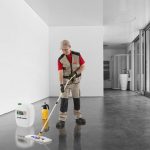
Functions of Impregnating Compounds
Concrete is characterized by porosity, and its strength characteristics are largely determined by the process of cement hydration. Due to the technological features of manufacturing, in the pores of concrete there is a gel component of cement, moisture and air. These elements adversely affect the properties of structures made of concrete.
Due to the presence of microscopic pores, concrete has two drawbacks:
- slight hydrophobicity, as moisture penetrates through the pores;
- low density of the material, which reduces its strength.
At the modern technological stage, it became possible to change the porous structure of concrete to waterproof. This is done with the help of impregnation.
Using impregnation allows you to solve such problems:
- protection against aggressive chemical substances and the environment;
- increase in material strength;
- increased wear resistance;
- lack of dust on the surface due to crumbling material;
- strengthening older designs;
- extension of the service life of concrete products;
- more attractive appearance of concrete surfaces.
Water-repellent compositions are used for processing concrete at such objects:
- exhibition complexes and retail premises;
- Warehouses
- car service workshops, car washes, parking lots;
- open spaces with concrete coverings;
- livestock farms;
- industrial enterprises;
- administrative and residential buildings.
to contents ↑Note! Depending on the application, the composition of the impregnation may vary significantly.
Requirements for waterproofing and increasing the strength of concrete
Concrete structures must meet a number of requirements:
- The surface must be dry. Moisture in pores is not allowed.
- The floor should be cleaned of dust and dirt.
- The most suitable temperature for soaking is from 20 to 25 degrees Celsius. Humidity should not exceed 90%.
- The temperature of concrete on the surface should be above +10 degrees Celsius. Although some formulations work at lower temperatures.
- Rollers and brushes must withstand solvent handling.
- Before applying the hydrophobic composition, the surface is treated with quartz fine-grained sand. This improves the adhesive properties of the material.
- The surface is cleaned from chips and cracks.
- Impregnation should not be applied to a concrete floor that is not yet ready, even if people are already walking on it. After the floor is made, at least 2-3 weeks should pass, only after this is impregnation allowed.
Impregnation classification
According to their content, the impregnating compositions are divided into two types:
- organic (polymer);
- inorganic (silicate).
Organic water-repellent solutions act on concrete as follows: the binder component fills the pores, improving the ability of the material to withstand aggressive influences and enhancing the water-repellent qualities of the coating. Impregnation also solves the problem of dustiness of the surface and improves its strength characteristics.
Inorganic impregnating compounds act differently. They are not aimed at filling the pores, but interact with external molecular compounds, which then dissolve and become immune to other reactions. Due to the interaction, concrete gains higher strength and water resistance.
When choosing an impregnating material, it is recommended to take into account such factors:
- Inorganic compounds are used for: dust removal at low cost, with significant surface irregularities, with large loads on the floor.
- Organics is relevant in the following cases: constant interaction with chemicals, maintaining an attractive coating, the need for dust removal of mosaics.
To date, the most common organics. This is due to the best functional characteristics of organic compounds.
Different impregnations differ in the method of exposure to the concrete base:
- Deep penetrating impregnating compounds (silicates, silaxins, silanes) contribute to the concrete flooding. Sealing components penetrate microscopic pores and interact with calcareous molecules, increasing calcium crystallization. Thus, the fluates reinforce the material from the inside.
- Liquid hydrophobic compounds form a thin protective film. An example is acrylate-based impregnation. The epoxy mixture and numerous types of polyurethane impregnations also act.
Acrylic Compounds
Acrylate-based impregnations are distinguished by affordable prices and acceptable quality. They protect the material from moisture and chlorides, are resistant to ultraviolet, preserve the natural color of concrete. Acrylic compounds allow dust removal of the coating. However, this type of impregnation is short-lived - their effect lasts no more than 24-36 months.
to contents ↑Polyurethane Compounds
Polyurethane is more effective than acrylates. Impregnating solutions based on polyurethane dedust the surface, are resistant to chemicals, moisture resistant, provide strength. Polyurethane solutions process not only concrete, but also cement screeds, blind areas from street pavers, objects made of stone and brick. Polyurethane penetrates deep into the concrete layer (up to 6 mm) and is used both indoors and outdoors.
Note! The use of polyurethane compositions implies the presence of a waterproofing layer under the concrete base, covering the penetration of capillary moisture into the structure of the material.
After processing with a polyurethane solution, concrete acquires several new qualities:
- strength increases to the level of M600;
- resistance to wear increases by 7-10 times;
- impact resistance is doubled;
- improves water resistance, resistance to chemicals;
- dusting is excluded;
- coating care becomes easier;
- the appearance of the surface becomes more attractive.
Polyurethane impregnating compounds are easy to use and financially beneficial. The impregnated surface begins to operate on the same day, when it comes to walking. In the case of transport, you need to wait three days for the concrete to gain maximum performance.
to contents ↑Epoxy compounds
Epoxy-based impregnations are used only indoors, as they do not withstand the effects of ultraviolet radiation and turn yellow. The composition is a mixture of two components, which includes epoxy resin and hardener. Phenols or tertiary amines act as the latter. The proportions between the hardener and the resin may vary depending on the consumer characteristics of the product. Compositions are available in both color and colorless designs.
The advantages of epoxy impregnation include the following qualities:
- high strength;
- resistance to abrasives;
- moisture resistance;
- slight shrinkage;
- lack of pungent odor;
- attractive appearance, as the surface resembles “wet concrete”.
The disadvantage of epoxy compounds is less resistance to the effects of chemicals and mechanical loads, when compared with polyurethane impregnations.
to contents ↑Impregnation Functionality
By functionality, the impregnating compositions are divided into the following types:
- reinforcing;
- water repellent;
- dedusting;
- coloring.
Hardening compounds
Hardeners are made on the basis of inorganic elements - priming silicates. They do not create a protective layer on the surface, as they penetrate deep into the structure of the material. Hardening compounds do not exfoliate and give concrete maximum wear resistance and a dust-free effect.
Until recently, deep moisture penetration impregnations were made on the basis of potassium and sodium silicates. Modern formulations are based on lithium silicates. Such impregnations exclude the possibility of efflorescence on a concrete surface. The material gains increased resistance to mechanical damage and moisture. Due to the deep impregnation, the strength of the surface layer is doubled or even tripled.
to contents ↑Water repellents
Water-repellent impregnations fill the micropores of the material, preventing further moisture from entering the coating. In addition, water-repellent compositions provide the following benefits:
- anti-mold effect due to the content of antifungal components;
- resistance to acids and salts, ultraviolet radiation, do not form efflorescence.
Water-repellent impregnations are often used to prevent the formation of mold in hydraulic structures, for example, in pools. Impregnation is used to protect structures operating on the street, since the features of the formulation increase the frost resistance of concrete.
Note! Water-repellent solutions do not protect the foundation from contact with groundwater. Protection of the foundation should be comprehensive and include waterproofing the structure.
to contents ↑Dedusting compounds
Solutions of this group are used to treat open surfaces exposed to significant mechanical stress. Impregnation improves the wear resistance of the material, makes it more resistant to chemicals, and makes it easier to care for the coating.
Coloring compounds
Giving concrete color is carried out by ordinary paintwork material or special color impregnation. Moreover, the painted surface wears out much faster. Color solutions seep into the material to a depth of three millimeters, which allows you to give color resistance.
to contents ↑Note! The painted surface will remain for a long time only in case of additional impregnation of concrete with a water-repellent solution.
Popular Impregnating Compounds
The market offers a huge variety of primers for concrete. Consider only the most famous of them:
- Strengthening composition "Protector". It is highly resistant to chemicals. It makes the surface stronger. It has a dust-free effect. Improves the adhesive properties of the surface. "Protector" is used to strengthen structures for various purposes, including runways, roads, sidewalks, etc. Firming impregnation is offered in 20-liter containers.
- XTREME HARD. It is a waterproofing primer on an inorganic basis. It includes silica dust, penetrating the concrete structure and interacting with the cement base. During the reaction, crystallized mass and structures appear that block micropores.
- "Retroplate". Hardening impregnation containing a modifier. This element is used for hardening and dust removal of a concrete structure. The primer is applied at temperatures above 5 degrees Celsius. Impregnation is incompatible with unripened concrete.
- "Proteksil." It is used to impregnate floors in industrial facilities. Protexil components protect concrete from the effects of mechanical damage and contact with chemicals. The impregnation layer dries in about 6 hours at a 20-degree air temperature.
- "Monolith 20-M." It is a universal primer. "Monolith 20M" is made on a water basis. It is environmentally friendly and fireproof. The action of the impregnating composition can reduce the occurrence of cracks, improve water resistance, increase resistance to wear, and also remove dust from concrete. The primer penetrates 20-30 mm into the material and increases the durability of the painted surfaces. Consumption "Monolith 20 M" - about 1 liter for every 3-5 square meters. m concrete base.
- "Aquastone." It has a powerful dedusting and water-repellent effect. "Aquastone" for cement screed penetrates deep into the structure of concrete, strengthening the material and improving its adhesive characteristics. Impregnation is possible in wet floors.
- "Flew." Primer with water repellent property for materials containing a cement base. “Fired” also gives resistance to chemicals.
- "Master floor." Refers to epoxy compounds. It is used for dust removal and strengthening of magnesia and concrete floors, as well as cement screeds. Thanks to the use of "Master floor" the strength of the base is tripled. A feature of the primer is the ability to soak a wet floor.
- Ashford Formula. The composition includes a water-based silicate polymer. The reinforcer "Ashford Formula" is designed for the treatment of floors experiencing intense mechanical stress (industrial enterprises, roads, logistics terminals, etc.).
- Litsil. The Russian development - Litsil - has the ability to remove dust, polish and strengthen concrete. It features affordable cost and environmental friendliness.
- "Ceresite." Primer "Ceresit" is used for hardening concrete, cement screeds, lime surfaces. Improves the adhesive properties of the material, increases the density of the surface and its resistance to moisture.
Alternatives
Impregnations have a lot of advantages, but they cost a lot. If desired, you can use alternative methods to improve the quality of concrete. The most common material is water glass. It has antifungal activity and creates a moisture resistant surface. However, it does not strengthen concrete at all.
Another primer option is regular varnish. Its properties are similar to liquid glass.
Concrete impregnation technology
You can do all the work yourself. To do this, you will need: an impregnating composition, a tool for applying impregnation (roller or brush), personal protective equipment, dishes for solution.
First, prepare the base:
- remove the loose part of the concrete surface;
- process the base using a grinder (going deeper by about 1.5 mm).
Next, prepare the primer. All ingredients are added to the two-component composition and mixed with a construction mixer. The primer is made in small parts, since it must be used no later than 45-60 minutes.
When the impregnation is ready, it is applied to concrete. In this case, make sure that there are no drips. If we are talking about the composition of deep penetration, the work is done in layers - with interruptions to dry. A surface is considered to be dry when it stops sticking. Most often, the drying of the first layer takes an hour, and the second - 2 hours. The final drying of the concrete occurs in 12-15 hours.
Primer consumption determines the condition of the surface being treated. In the case of old concrete, more impregnation is needed. Most primers are consumed when impregnated with aerated concrete, due to the large number of pores. On average, when performing outdoor work, 100-200 g of liquid per 1 square. m. The porous surface will require up to 500 g per 1 square. m. In other words, a room of 25 square meters. m may require from 2.5 to 12 kg of impregnation.
Particular attention should be paid to safety. Personal protective equipment must be used, including a respirator, cotton bathrobe, rubber gloves and shoes. If the solution gets on the skin, it is immediately washed in running water with a soapy solution and wiped with a clean piece of cloth. When the primer comes in contact with the mucous membranes, they are washed with water and immediately seek medical help.


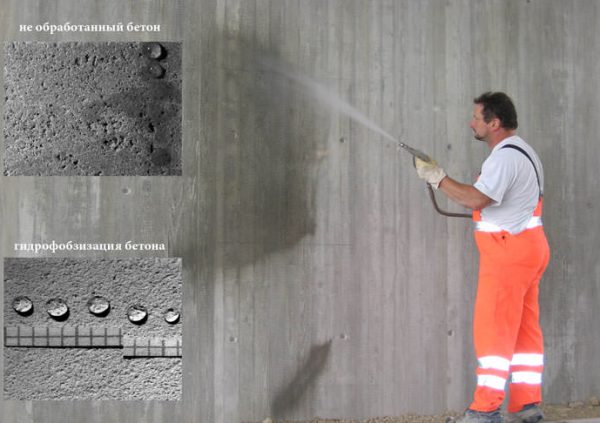
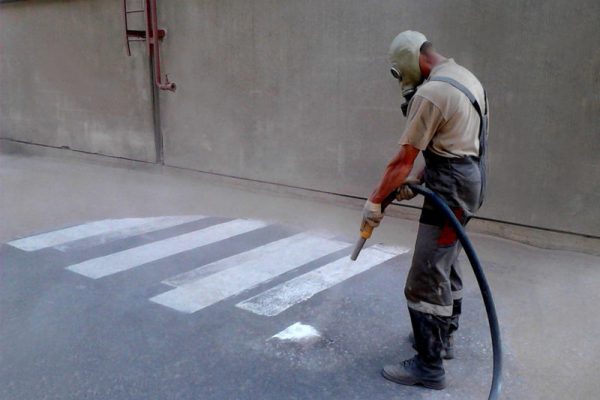
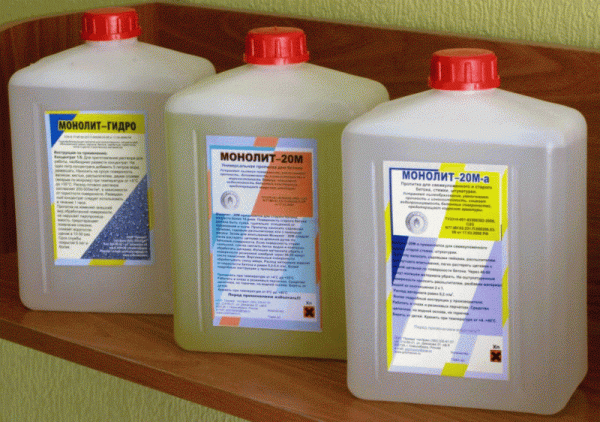
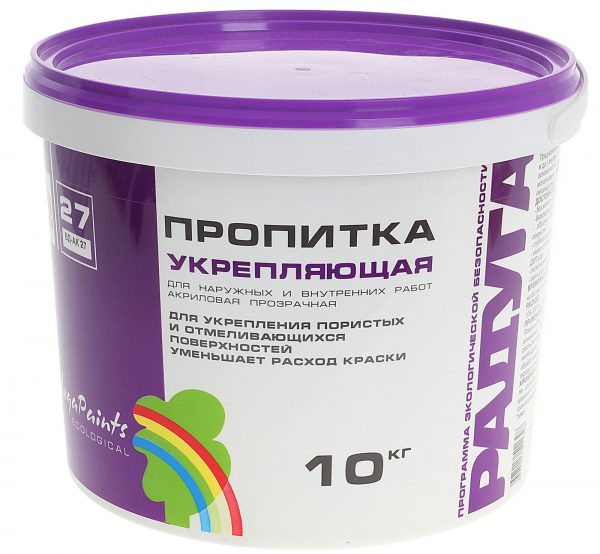
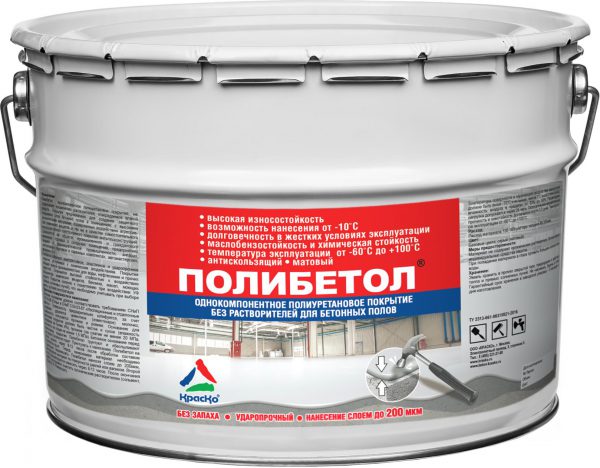

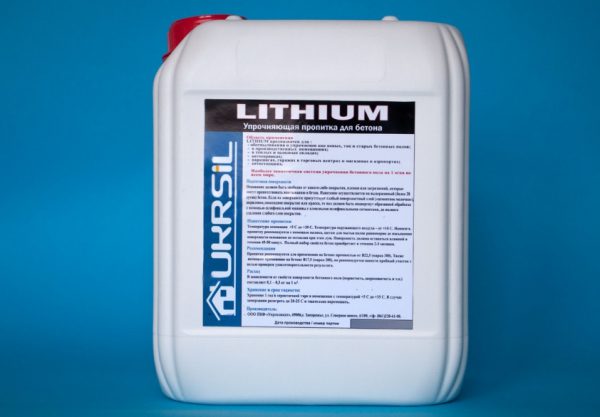
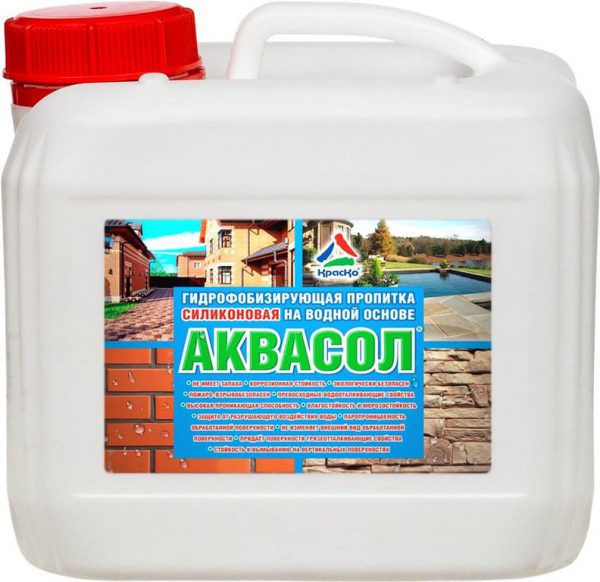






Hello! I would like to consult with you.
Initially, my choice was Proteksil, now I got acquainted with KrasKo's Aquastone and selected it according to the description ..
The fact is that on the M250 year-old concrete floor of an unheated garage, in some places a repair composition was applied with a layer from 0 to 5 mm (repair of small pits and defects), previously the base was primed with a usual, not expensive expensive deep penetration acrylic primer.
Now I would like to strengthen the floor with a serious impregnation of “Aquastone” (though I fear that the primer will impede the penetration of the impregnation)
But after applying Aquastone I plan to apply in some places the cement composition of the fine fraction, in order to smooth out minor defects that the repair composition of the large fraction could not cope with,
And I want to shut off this cement composition with 50 to 50 water with Aquastone (according to the instructions this is possible)
And then I’ll think about painting or maybe I will limit myself to propika as an independent layer ...
What is your opinion about my plans?
Is Aquastone suitable for and for how much?
Can Aquastone penetrate a previously applied regular acrylic primer (pre-walk with a metal brush)?
Will a thin layer of cement mix lie normally on the base impregnated with Aquastone? Or maybe the mixture should be applied to the wet-wet impregnation for better adhesion?
Is it possible to leave Aquastone as an independent layer without further painting?
Maybe the last layer of impregnation can be tinted with something?
Does impregnation withstand studded tires of a car?
I recommend applying Protexil acrylic impregnation. It is designed to protect industrial floors from aggressive environments and increased mechanical and transport loads. I believe that old organic acrylic impregnation will prevent the application of an aqueous solution of Aquastone.
But on the other hand, if you clean the floor with a metal brush to ensure good adhesion of the surface to the impregnation of Aquastone and when mixing dry cement mixes with water (it is possible to replace part of the water up to 50% with Aquastone material), you can get a good result.
I still recommend organic impregnation of the Protexil brand and if you want to create protective and decorative properties, use Texil paint for concrete floors.